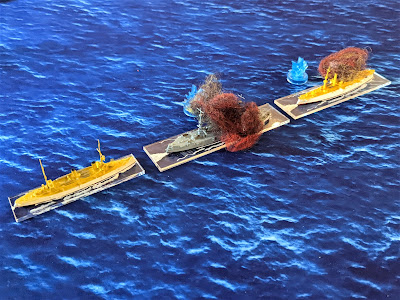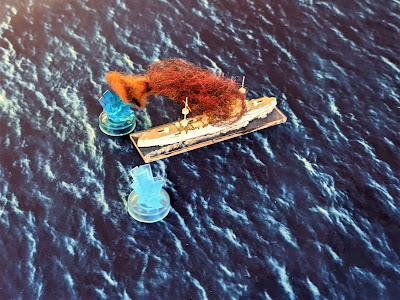We played the second of the mini-DANG (Dave’s Annual Naval Game) games today. Those of you that follow the blog will remember the games were postponed due to snow. We were only missing one person for this session. Today’s game was World War 2 coastal forces action in the Black Sea. The Soviets have launched an amphibious attack across the Kerch Strait (Note: Historically would have been part of the Kerch–Eltigen operation in late 1943). Soviet naval forces are supporting the attack with supply runs, bombardment missions, and minelaying to prevent interference from the Germans. The Germans are trying to stop the Soviets, while providing their own naval support. We used David Manley’s Narrow Seas coastal forces fast-play rules to resolve today’s action and Warlord Games 1/300 scale Cruel Seas coastal forces with a few scratch-built merchants.
 |
Soviet ships preparing for the operation
|
The Soviets had a Project 53-U (Fugas) class minesweeper, 2 Project 1124 Bronekater armored gunboats, a pair of MO-4 submarine chasers for escorts, and 3 merchant supply ships (Note: Historically the Soviets would have been using Project 165 landing craft, but I don’t have any of those right now and so the merchants are substituted in). The Soviets started on the east edge of the board and basically had to exit the merchants, Bronekater gunboats, and minesweeper off the west edge. They had the option of staggering their entry over the first 3 turns but chose to have everyone enter on turn 1.
 |
Soviet forces
|
The Germans had a pair of S-boats (S-30 class) motor torpedo boats (MTBs), an AFP flaklighter, an R-boat motor minesweeper, and three Italian MAS MTBs (Note: Historically these boats were turned over to the Romanian when the Italians left the theater. In this game I gave them a random quality and 2 of the 3 crews were green). The Germans we tasked with stopping any Soviet support from getting through to the beachhead. The AFP flaklighter and R-boat started on the west portion of the board, the S-boats entered on the northwest edge on turn 1, and the MAS boats entered the southwest edge on turn 3.
 |
S-boat on the prowl
|
We used hidden units and dummies for the game. I was trying to give the players a chance to hide their intentions and try to scout things out. But being normal gamers, they moved straight into action.
 |
German hidden ship markers
|
The larger ships sighted each other pretty quickly. So, the Germans knew right where the Soviet supply ships were and also spotted the minesweeper, while the Soviets spotted the German AFP. Early shots by the big ships were fairly ineffective, with each side only doing light damage to the other.
 |
Soviet supply ships
|
 |
Soviet minesweeper
|
 |
German AFP bristling with weapons
|
With the supply ships spotted, the S-boats made their way to intercept and fired their torpedoes. On the other side of the board, the MAS boats moved on and launched torpedoes at the minesweeper, while the other two too long-range torpedo shots at the supply ships.
 |
S-boats launching torpedoes at the supply ships
|
 |
MAS boat launches torpedoes at the minesweeper
|
The Soviets tried to evade the incoming torpedoes. One supply ship was able to turn bow-on to the torpedoes and both missed. The other supply ship and the minesweeper were not so lucky, with both taking hits and drifted to a halt (Wrecked in the game rules). Even with these losses, the Soviets still had the Bronekater gunboats and two supply ships that could complete the missions to win the game.
 |
Torpedo hit!
|
 |
Minesweeper sinking
|
With their torpedoes shot, the German S-boats and Romanian MTBs began a retreat. The S-boats looked at reloading their tubes. But it would take 5 turns at slow speeds to do it and the Soviets would be gone by then. The AFP continued to blast away at Soviet ships, but was not having much luck. The R-boat decided to try to drop some depth charges in the path of the supply ships, hoping to disable or sink them. But the R-boat had to fight its way through the MO-4 escorts.
 |
R-boat in close action with an MO4 escort
|
On the other side of the board, the Bronekaters caught site of the fleeing MAS boat that had torpedoed the minesweeper and hit it squarely with a 76mm round, sinking the little boat.
 |
Bronekaters blast the MAS boat
|
 |
MAS sinking
|
The R-boat was able to get in front of the supply ships and started dropping depth charges. It narrowly avoided colliding with one of the supply ships (only the paint was scratched). However, the supply ships were able to make their way through the depth charge patterns with only wet decks.
 |
Near-miss on the collision
|
In the middle of the board a fight was developing between the AFP and the Bronekaters. The AFP’s bad rolls continued, and it couldn’t connect any good hits on the gunboats. While the gunboats were getting hits on the AFP.
 |
AFP faces of against the Bronekater gunboats
|
At this point we decided to call the game. There wasn’t much the Germans could do to stop the remaining supply ships from getting off the board and the AFP was having no luck against the gunboats. With this in mind we gave the Soviets a minor victory.
Overall, the scenario played out well. The Soviets could have delayed the entry of their supply ships to allow the other ships to deal with the Germans before they could get into torpedo range. But it is hard to argue with the plan that won the game.
It was a fun game and everyone had a good time and enjoyed the rules, which lived up to their billing of fast play rules. The Warlord ships look good on the table, I only wish they were coming out with some more useful ships.









































